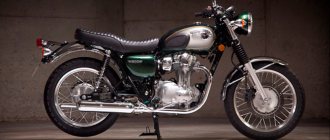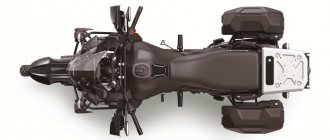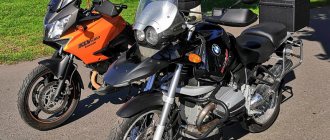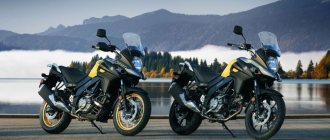Kawasaki J300 – TEST
Jyonetsu
2014 onwards, 299 cm3, 28 l. s., 191 kg (curb weight), 147 km/h, 282,900 rub.
text: Daniil Kochergin photo: Evgeny Bobrikov
"People's wisdom is inexhaustible! But even centuries-old rules have their exceptions. For example, the expression “The first pancake is lumpy” in 99 cases out of 100 is the best fit for the first unsuccessful attempts. Then comes a series of error corrections, elimination of shortcomings, and only then - the result that everyone recognizes. However, there are isolated cases when the outcome of an undertaking is ideal right away. And, as a rule, for good reason. A prime example of this is the new Kawasaki J300, the Japanese giant's debut in the scooter segment and an almost exact copy of the Kymko Downtown 300i. So what is it? Undisguised deception of the consumer or an ordinary marketing ploy in the conditions of modern competition?
The letter “J” in the name of the scooter is an abbreviation for the Japanese word Jyonetsu, which means “passion”. This is precisely the feature that a high-quality, but, in my opinion, absolutely faceless Taiwanese scooter lacks. Kawasaki engineers and designers decided to correct this unfortunate circumstance, killing two birds with one stone: they filled the faded form with samurai character and entered a new fantastically capacious market with an excellent debut model. The aggressive notes characteristic of the sporty representatives of the Kawasaki family are visible to the naked eye: the designers of the “green giant” worked on the appearance of the J300, scrupulously observing the impressive corporate style. At first glance, attention is drawn to the headlight unit, the sharp, broken lines of which unconditionally refer to the Kawasaki Ninja model line.
The similarity is also emphasized by the diode “turn signals”, made in the same style as the side light of the “shadow warriors”. Even the front fender, like the twenty-fifth frame, complements the feeling of kinship with the “adult” motorcycles of the brand - in shape it is almost indistinguishable from a similar element of the monstrous Kawasaki Ninja ZX-14R. If you look at the device from the front, then the fact that this is a scooter, and not a “supersonic” car, is only reminded by a slight contradiction in the size of the large windshield and the small 14-inch wheel. As soon as you turn the scooter 3/4, you will see unrecognizable redesigned side plastics, as well as eye-catching tunnel trim. The multi-segment two-tone design has transformed the Taiwanese base so much that it is possible to discern kinship with the Downtown 300i only in rare nuances. There is not a single “boring” plane to be found here - the entire image of the Kawasaki J300 is subordinated to the variety of angles and edges and creates the impression of swiftness and energy.
Of course, the concept of “big sport” does not apply to a “green” scooter, but the softer concept of “fitness” is quite possible. The manufacturer associates the sports component exclusively with a special chassis setup. For the sake of dynamic piloting, some restrictions on comfort have been allowed, and this is noticeable - the Kawasaki J300 is really harsh. Due to the specific tuning of the suspension, which has even less travel than the chassis of 600 cc sportbikes, as well as the small diameter of the wheels, the rider feels slightly “chilled” on small imperfections in the road surface and shakes noticeably when crossing larger obstacles. Speed bumps, for example. However, this situation also has its own logic: it doesn’t shake much more than its classmates, but the J300’s handling is an order of magnitude better, and the stability of the device both during braking and acceleration is excellent. The maximum tilt angles, by the way, are limited only by the capabilities of the rubber: structurally, the scooter does not have a single particularly “standout” element, and only the imperfections of the road surface and the pilot’s sense of self-preservation prevent the J300 from “laying” to the edge of the tire tread.
But the scooter owes its extraordinary physical fitness not only to the chassis. Despite the excessive modesty of Kawasaki engineers, who do not advertise the merits of the borrowed Kymko power plant, the J300 engine deserves special mention. Let's start with the fact that among scooters with the quality designation “300”, the Kawasaki product (like its progenitor) is the most honest. The engine capacity of J300 is 299 cm3, while for other representatives of a similar “weight category” it reaches a maximum value of 278 cm3 (Vespa GTS 300, GTV 300) - 279 cm3 (Honda Forza 300, Honda SH300i). It is also interesting that on the dynamometer stand, the new Kawasaki product demonstrated maximum engine power even more than stated by the manufacturer - 33, not 28 hp. With.! Having repeatedly encountered inconsistencies between what was declared and what was available, I am inclined to believe in the possibility of an error in favor of the Kawasaki product. Unaccounted for additional forces are clearly noticeable in the race for maximum speed, and the behavior of the scooter fully confirms the data from the stand. I managed to accelerate the J300 to 140 km/h, and when driving at speeds up to 130 km/h, acceleration is accompanied by confident acceleration - and only the last 10 km/h are difficult. Moreover, in the “greenhouse conditions” of the dynamometer stand, in the absence of losses due to air resistance, the maximum was slightly more - 147 km/h. Agree, not bad for a scooter with a 299 cc 1-cylinder engine!
The Kawasaki's speed performance is quite sufficient both in a modern city and for long country trips (of course, if the route is laid only on good quality roads). Possessing decent acceleration dynamics, the J300 retains a more than modest “appetite”. The “smart” electronic fuel injection system is responsible for particular efficiency, which takes into account multiple parameters and indicators - and accurately doses the mixture, which is then supplied to the combustion chamber through a 34-mm damper. As a result, fuel consumption per 100 km does not exceed 3.4 liters, which, together with a 13-liter gas tank, will allow the Kawasaki scooter to travel more than 350 km without refueling. The tank, by the way, is located below the level of the footrests, which has a positive effect on the handling of the device. But whether the J300 will have “smart” brakes is up to you to decide. The model is available in two versions: with and without ABS. In both cases, the rider's safety is ensured: at the front there is a 260 mm disc and a 2-piston caliper, at the rear there is a 240 mm disc and a 1-piston caliper. The version with ABS is equipped with a lightweight Bosch control unit. The device received for testing was equipped with an anti-lock braking system and during its entire operation did not cause a single complaint regarding braking: ABS performed the tasks assigned to it perfectly - even in those moments when the tasks came into conflict with common sense...
In addition, the Kawasaki J300 has excellent ergonomics and is still not too bad in terms of comfort. The excessive stiffness of the suspension is 100% compensated by the amazingly comfortable seat. I’ve probably never found anything more comfortable on any scooter, and the déjà vu that inevitably arises when you sit on it (namely “in”, not “on”!) is associated more with the comfort of a passenger car than with a two-wheeled vehicle. The only “but” is that you can’t stretch your legs (there’s simply nowhere). All controls are at hand and are made of very high quality. To the left of the dashboard there is a glove box with a 12V socket. Its location allows you not only to safely charge your phone while driving, but also to power your GPS navigator. The J300 doesn't have the most spacious seat space. It is enough for one helmet and a small briefcase, but this circumstance is not annoying, because the capacity of the “hold” is enough for transporting everyday belongings, and for a long journey you still cannot do without additional panniers.
The reclined seat is fixed in the raised position by a pneumatic strut - it is worth noting that this “option” is not typical for devices in the J300 price category. In addition, the luggage compartment of the scooter is illuminated. I’m not the most ardent fan of “lazy” and “impressive” two-wheelers, but the J300 managed to hook me. Everything about Kawasaki’s debut scooter is thoughtful and precise, and even the fingers of one hand would be too many to list the shortcomings (unless that hand belongs to an unlucky turner). /
A friend approached me with the standard questions of a newbie who was tormented in choosing a cubic scooter. He categorically did not want a motorcycle, so I did not try to convince him, knowing him and how inattentive he is to things and details. For a long time I could not understand how to characterize this type of driver. He wasn’t one for dummies; in his 40 years, half of his life was behind the wheel of a car, but sometimes he turned on the stupid thing and drove extremely inattentively and constantly making the same mistakes, out of a lack of desire to remember and learn. Therefore, I affectionately called him a humanitarian and explained why. A friend wanted a mid-sized sofa scooter, so I had to remember all my friends who once rode Burgmans, Skyways and others. I even came to visit someone and tested a maxsym 400 with a mileage of 40k, since the new one cost exactly the money that my friend was counting on. Maxim seemed weak to me. I had to catch him in turns, hold the dangling steering wheel when braking, and also watch for his attempts to bite the sides of my legs in traffic jams. Maybe it was already worn out, but the owner assured that it was fully serviced, looked after, etc. He wouldn't lie, there was no point.
Having once ridden the Aprilia Sportcity 200 for two seasons, I had a good idea of what a good scooter was. It wasn't a sofa, of course, but still.
Then I looked closely at Stealth, Chinese, Yamaha Majesty and others. Of course, ideally we should have taken T-Max or Gillera, but this is a different price segment.
Then I came across a topic on the Kava forum that the first scooter in the company’s history had been released, and since I was a fan of the “green brand,” I decided to study it in detail.
Having searched the vast Runet, I could not find a single Russian-language review of the Kawasaki j300. There were superficial videos on YouTube - maximum speed, promotional videos, official videos, etc., which did not give the full picture. I wanted details, so I packed up and went to the dealer.
First of all, I was wary that Kava did not develop it itself, but modified the Kymco scooter. But what can we do, we live in times of marketing, competition and cheaper production. For example, the bulk of popular Honda models are assembled in China, what can we say?
Arriving at the officials, I began to feel, click, tilt, pump, in general, I did everything to understand at least something without leaving. Unfortunately, few people test drive Japanese motorcycles, and only at official events that have to be waited for.
Which surprised and pleased. — All the buttons are switched on clearly, the quality of the materials is excellent, when the turn signals are turned on, the relay clicks — it’s a double sensation, but you can hear it at low speeds! There is no need to constantly check whether they are turned on or not. — The handles and the quality of the grips are excellent — There are comfortable cutouts on the sides for the feet so that they don’t get caught when stepping between the rows and for passive safety (as scooter riders like to put their legs out to the sides at low speeds). — Suspension. Compared to the Maxim, the front suspension is much stiffer, and gas rear shock absorbers are standard - i.e. Already different settings for active taxiing - LED white dimensions - Landing, probably a plus rather than a minus. You can’t stretch your legs, but the steering information is better, after all, it’s a city scooter. You can also press the stiffening ridge with your feet. I remember on the Gillera Runner such a ridge helped balance and steer. Although many people need to stretch their legs. — There are many native special stages.
What I didn't like. — First of all, the weight. It is no different from its competitors and this, in my opinion, is a flaw. We left it as is. — Unlike the Korean Maxim, the headlights are ordinary, not lenses. — Blue tidy, as I understand it, got from Kymco. — Vibration, although girls like it) Otherwise, I didn’t find any difference.
This is from what I remember. In the second part I will try to make a video review.
Ps While I was talking with the seller, a man about 50 years old came into the store with a well-dressed young lady. Gesturing, he told the seller that he had bought the same one, and the lady smiled broadly and said that sometimes she also tries it and how much she likes it).










